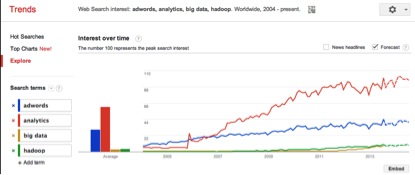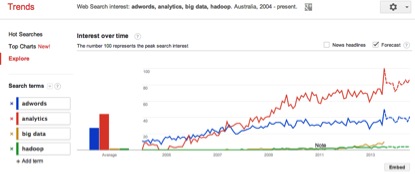Rod Jacka and Panalysis has been a friend of Parachute Digital before it existed. Rod is one of Shanelle’s mentors and there is no one in Australia who knows more about online data analysis than Rod Jacka.
Just how big is big data? It seems that it is the topic of discussion in any number of spheres today but is it something that you need to pay attention to or is it just hype?
Marketing professionals are being asked to increase their levels of expertise across a growing number of areas. It is difficult to keep up and stay focused with so many competing demands. Is it worth investing your time in learning about big data and associated areas such as analytics?
Google Trends can help put questions like this into context. It may seem a little odd to be using big data to answer a question about big data but it might just give you an inkling of the persuasive magic of this powerful area of knowledge.
To put things into context I started with the ever-familiar AdWords as a benchmark. We know that AdWords is a key driver of Google’s huge success. Almost every marketer is familiar with Adwords, and it is an integral part of most marketing strategies. So taking the number of searches related to AdWords over the past nine years is a good baseline to assess interest in the areas of big data and analytics.
The following chart shows a comparison of the number of Google searches for ‘adwords’, ‘analytics’, ‘big data’ and one of the new technologies for dealing with large datasets, a solution named ‘hadoop’ (which by the way is named after the engineer’s son’s toy elephant).

You can see how many more people are using online marketing and analytics tools in recent years
Analytics is the stand-out performer, starting, not surprisingly, in early 2006 when Google Analytics was released, and interest has continued to grow steadily. Analytics-related searches are approximately double those on ‘adwords’. ‘Big data’ and ‘hadoop’, by comparison, are relatively small but are growing.
Limiting the data to just Australian searches shows a similar picture.

Australian search trends show that we are using online marketing tools more than ever as well
We can’t be sure why people are searching for these topics but we can learn from the trend that there is growing interest in the areas of analytics and big data.
Big data means many things but one thing is becoming clear. Analytics and data (big or small) are important parts of the marketer’s professional tool kit and this is likely to be more than a fad. But marketers need to beware – there are many success stories, but there are also dangers and pitfalls.
Big Data Success Stories
Many companies, including marketing companies, are using the data their business models generate to build new products or provide better services.
MailChimp are using their own big data, gleaned from the results of over 35 billion emails sent every year, to help their 3 million users make better decisions, reduce spam reports and gain higher conversion rates.
Passur Aerospace aggregates real-time data from a range of sources into its RightETA product, which provides the most accurate flight arrival estimates, optimising airport and airline and flight crew management.
Gracenote, the company that provides the metadata for music files around the world, has become ubiquitous and is now using its huge dataset on worldwide music use to develop a range of new recommendation engines.
Dangers and Pitfalls of using Online Data
Andrew Pole’s work on predicting pregnancy among Target customers had some unfortunate results when the company knew more about some customers than their family members did. ‘Target’-ed marketing, indeed.
Qantas mined data to identify highly profitable customers but their staff’s use of this information in customer interactions tended to ‘creep out’ these high value customers, rather than engage them. It’s not clear if the answer is employees who are better actors, or different use of the data.
Urban Outfitters’ attempts to reduce superfluous marketing of male clothes to female customers inspired a backlash from women who resented gender-based marketing. It turns out personalisation can have diminishing returns once the ‘creep’ factor kicks in.
The future of marketing
It seems likely that marketers are not going to engage directly in big data processes at this stage, even though their expertise in customer comfort levels will be crucial to avoiding the ‘creep factor’ mentioned above . Probably marketers will find themselves using the data-based tools that are developed by the “quants”, and inserting that customer-focus at a later stage. Marketing professionals are in a good position to discern which data will be useful, and which might be counter-productive.
What is clear, however, is that life in the marketing disciplines is going to change because of the widespread use of big-data tools and insights. Whether your company is investing in the development of these technologies, or watching cautiously from the sidelines, data-driven marketing is a growing and increasingly successful part of the marketer’s toolkit. All direct marketing will soon be data-driven.
You don’t need to know its inner workings, or qualify for the ‘data scientist’ job description, but a keen interest in, and a good understanding of, analytics and big data are going to be requirements for the marketing professionals of the future.
